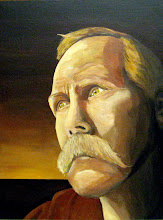Friday, August 29, 2008
Thursday, August 28, 2008
Village in the Valley
 Here is another example of a 'reverse painting'. I painted the canvas black and then added the elements of the painting from foreground to background. It is the process of actually painting that is satisfying, not just the end result. This painting began in darkness and then the sun rose and illuminated the scene.
Here is another example of a 'reverse painting'. I painted the canvas black and then added the elements of the painting from foreground to background. It is the process of actually painting that is satisfying, not just the end result. This painting began in darkness and then the sun rose and illuminated the scene.
Wednesday, August 27, 2008
Reverse Painting: The Bathers
 Reverse painting, as I call it, (some would say 'backwards') begins just like 'blotchilism' with the canvas painted black. Painting proceeds from the front to the background. In this case, the figures were painted in first and the sky last. Black is reserved around each of the elements in the painting. Strange, I know, but it achieves a pasted cut-out effect that would not be produced otherwise.
Reverse painting, as I call it, (some would say 'backwards') begins just like 'blotchilism' with the canvas painted black. Painting proceeds from the front to the background. In this case, the figures were painted in first and the sky last. Black is reserved around each of the elements in the painting. Strange, I know, but it achieves a pasted cut-out effect that would not be produced otherwise.
Labels:
reverse painting,
Three Bathers,
Two Bathers
Tuesday, August 26, 2008
Still Life in Green and Red
 The alternate title of this painting is "Tea For One", but it added a depressing predisposition to a cheerful little piece. The red-checkered tablecloth was the toughest challenge. The solution was to use quick drying acrylic paint for the tablecloth while the rest of the painting is oil. Simply an extrapolation of the adage "fat over thin".
The alternate title of this painting is "Tea For One", but it added a depressing predisposition to a cheerful little piece. The red-checkered tablecloth was the toughest challenge. The solution was to use quick drying acrylic paint for the tablecloth while the rest of the painting is oil. Simply an extrapolation of the adage "fat over thin".
Labels:
ParnellArt,
red-checkered tablecloth,
still life
Monday, August 25, 2008
Blotchilism

 Paintings with defining black lines around objects and figures have always appealed to me. It is usually accomplished by 'drawing' the structure of the painting in black lines and then adding the color much like a coloring book. A variation would be to add the defining lines after the bulk of the painting is done. My attempts at these techniques did not produce the results I desired, so I devised a technique I jokingly call 'blotchilism'. The whole canvas is painted black and then color is added in blotches more like 'colorforms'. Using small 'taches' of color while always leaving black around them produced and interesting mosaic look. Larger lines and areas of color are used for structure.
Paintings with defining black lines around objects and figures have always appealed to me. It is usually accomplished by 'drawing' the structure of the painting in black lines and then adding the color much like a coloring book. A variation would be to add the defining lines after the bulk of the painting is done. My attempts at these techniques did not produce the results I desired, so I devised a technique I jokingly call 'blotchilism'. The whole canvas is painted black and then color is added in blotches more like 'colorforms'. Using small 'taches' of color while always leaving black around them produced and interesting mosaic look. Larger lines and areas of color are used for structure.

Sunday, August 24, 2008
Modern Family
 My goal in "Modern Family" was to combine a diverse set of elements from modern art into one painting. The background is obviously sampled from Mondrian with solid blocks of primary colors defined by simple black lines. To me, Piet Mondrian's work is almost the definition of 'modern'. The canvas is 1.5" thick and the sides are also painted in primary or secondary colors surrounded by black lines so that any approach to the painting will expose another block of color.
My goal in "Modern Family" was to combine a diverse set of elements from modern art into one painting. The background is obviously sampled from Mondrian with solid blocks of primary colors defined by simple black lines. To me, Piet Mondrian's work is almost the definition of 'modern'. The canvas is 1.5" thick and the sides are also painted in primary or secondary colors surrounded by black lines so that any approach to the painting will expose another block of color. The women have elements borrowed from Modigliani, especially the long, graceful, exaggerated necks. The peaceful expressions and almost closed eyes are reminiscent of Issa Shojaei and the multiple perspective of the faces is from Picasso. The subject matter is certainly modern, raising issues of morality, family, gender, and race.
Subscribe to:
Comments (Atom)




